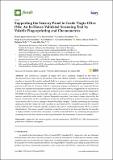Por favor, use este identificador para citar o enlazar a este item:
http://hdl.handle.net/10261/223757COMPARTIR / EXPORTAR:
 SHARE
BASE SHARE
BASE
|
|
| Visualizar otros formatos: MARC | Dublin Core | RDF | ORE | MODS | METS | DIDL | DATACITE | |

| Título: | Supporting the Sensory Panel to Grade Virgin Olive Oils: An In-House-Validated Screening Tool by Volatile Fingerprinting and Chemometrics |
Autor: | Quintanilla-Casas, Beatriz; Marin, Marco; Guardiola, Francesc; García-González, Diego L. CSIC ORCID ; Barbieri, Sara; Bendini, Alessandra; Gallina Toschi, Tullia; Vichi, Stefania CSIC ORCID; Tres, Alba | Palabras clave: | Virgin olive oil Sensory quality Volatile compounds HS-SPME–GC–MS Chemometrics Panel test Validation Untargeted |
Fecha de publicación: | 21-oct-2020 | Editor: | Multidisciplinary Digital Publishing Institute | Citación: | Foods 9 (10): 1509 (2020) | Resumen: | The commercial category of virgin olive oil is currently assigned on the basis of chemical-physical and sensory parameters following official methods. Considering the limited number of samples that can be analysed daily by a sensory panel, an instrumental screening tool could be supportive by reducing the assessors’ workload and improving their performance. The present work aims to in-house validate a screening strategy consisting of two sequential binary partial least squares-discriminant analysis (PLS-DA) models that was suggested to be successful in a proof-of-concept study. This approach is based on the volatile fraction fingerprint obtained by HS-SPME–GC–MS from more than 300 virgin olive oils from two crop seasons graded by six different sensory panels into extra virgin, virgin or lampante categories. Uncertainty ranges were set for the binary classification models according to sensitivity and specificity by means of receiver operating characteristics (ROC) curves, aiming to identify boundary samples. Thereby, performing the screening approach, only the virgin olive oils classified as uncertain (23.3%) would be assessed by a sensory panel, while the rest would be directly classified into a given commercial category (78.9% of correct classification). The sensory panel’s workload would be reduced to less than one-third of the samples. A highly reliable classification of samples would be achieved (84.0%) by combining the proposed screening tool with the reference method (panel test) for the assessment of uncertain samples. | Descripción: | 14 Páginas.-- 3 Tablas.-- 2 Figuras | Versión del editor: | http://dx.doi.org/10.3390/foods9101509 | URI: | http://hdl.handle.net/10261/223757 | E-ISSN: | 2304-8158 |
| Aparece en las colecciones: | (IG) Artículos |
Ficheros en este ítem:
| Fichero | Descripción | Tamaño | Formato | |
|---|---|---|---|---|
| foods-09-01509.pdf | Artículo principal | 737,97 kB | Adobe PDF |  Visualizar/Abrir |
CORE Recommender
Page view(s)
164
checked on 26-may-2024
Download(s)
171
checked on 26-may-2024
Google ScholarTM
Check
Este item está licenciado bajo una Licencia Creative Commons

